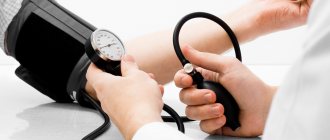Trembling inside the body can occur for various reasons. Doctors at the Yusupov Hospital conduct a comprehensive examination of patients using the latest equipment from leading manufacturers in Europe, Japan, and the USA. After receiving the results of instrumental and laboratory studies, at a meeting of the expert council with the participation of candidates and doctors of medical sciences, doctors of the highest category, a collegial decision is made on further tactics for treating patients.
Body tremors can be a natural reaction to stress. With strong anxiety, the body increases the production of stress hormones - adrenaline and cortisol. They become the source of energy necessary to eliminate the situation that has arisen. An excess of completely unused internal energy causes tension and trembling within the body. Trembling in the body is observed in people who are trying to hide their emotions. In this case, unrealized hormones remain inside the body and cause overstrain, manifested by trembling of individual muscle fibers or muscle groups.
The cause of internal body tremors may be autonomic dysfunction. An imbalance between the sympathetic and parasympathetic parts of the autonomic nervous system can occur during chronic stress, depression, after suffering a severe infectious disease, or as a result of chronic somatic pathology. The cause of trembling inside the body can be pathological processes in the cerebellum, thalamus, hypothalamus, subcortex or cerebral cortex. Trembling in the body is one of the signs of complications of diabetes mellitus.
Under stress
Acute stress occurs due to a one-time exposure to a strong traumatic factor. It is accompanied by trembling in the body, psycho-emotional agitation or a depressive state. Chronic stress develops with prolonged exposure to unfavorable factors:
- interpersonal conflicts;
- tense family relationships;
- monotonous and unloved work;
- lack of vital interests;
- lack of personal communication;
- long absence of vacation.
Patients in a state of chronic stress are unsure of themselves and others. They experience nervous disorders and panic attacks, during which trembling occurs inside the body, increased sweating, and increased body temperature. Emotional lability, vulnerability, and touchiness develop.
To eliminate the symptoms of stress and tremors within the body, neurologists at the Yusupov Hospital prescribe tonics and sedatives, herbal remedies, and vitamin and mineral complexes to patients. In the rehabilitation clinic, physiotherapeutic procedures are carried out to balance the processes of excitation and inhibition in the cerebral cortex. Psychotherapists use innovative psychological techniques.
Consequences of muscle twitching
The causes of nervous tics can be:
– lack of vitamins and microelements such as potassium or iron;
- head injury;
– prolonged emotional and mental stress;
– strong feelings;
– pinched nerve;
– neuralgia or vegetative-vascular dystonia.
Consequences that can result from lack of treatment for nervous tics:
– pinched nerve and increased muscle tension;
– if the cause of a nervous tic is vegetative-vascular dystonia, then the result may be a circulatory disorder;
– a nervous tic caused by excessive physical exertion can lead to convulsions or partial loss of limb mobility.
For autonomic dysfunction
Autonomic dysfunction is a complex of clinical manifestations of a functional disorder of the autonomic nervous system, which entails disruption of the functioning of internal organs. This is a specific syndrome that can accompany any somatic pathology.
Violation of nervous regulation on the part of the autonomic nervous system can be provoked by one of the following factors:
- burdened heredity;
- hormonal dysfunction;
- diseases of the endocrine system;
- organic brain lesions;
- unfavorable external factors leading to constant psycho-emotional stress.
Patients with autonomic dysfunction complain of rapid heartbeat, periodic feeling of a sinking heart, pain in the heart area. They are worried about rapid breathing, difficulty or inability to take a deep breath or exhale, a feeling of lack of air, and causeless attacks of shortness of breath. There are fluctuations in blood pressure, a feeling of coldness in the extremities, and periodic fluctuations in body temperature. The functioning of the digestive organs is disrupted - abdominal pain, constipation alternating with diarrhea, nausea, vomiting, and belching occur.
Patients note general weakness, decreased performance, and lethargy. They experience excessive irritability, impaired sleep quality, frequent dizziness, a constant feeling of anxiety, and periodic trembling within the body. Diagnosis of autonomic nervous system dysfunction is often difficult.
At the Yusupov Hospital, doctors conduct a comprehensive examination, including registration of an electrocardiogram, rheovasography, rheoencephalography, computer and magnetic resonance imaging. Patients in the neurology clinic are advised by cardiologists, endocrinologists, and gastroenterologists.
To treat autonomic dysfunction, neurologists use medication to relieve acute attacks. Patients are prescribed herbal medicines, physiotherapeutic procedures that improve sleep quality, diet therapy and physical therapy. Psychologists use innovative psychotherapeutic techniques.
First aid
Emergency assistance for venous pulsation is often required.
- In case of pneumothorax, you must call an ambulance; if the wound is open, it must be covered with a bandage (preferably sterile); in case of valve pneumothorax, you need to puncture the damaged area with a sterile needle.
- If cardiac tamponade or aneurysm rupture is suspected, urgent hospitalization is also required. Patients experience pale skin, decreased blood pressure, increased heart rate, and shortness of breath.
- When an aneurysm ruptures, unbearable pain occurs in the thoracic region with radiation to the lower back. It is important to call an ambulance; before it arrives, you need to provide the patient with peace, an influx of oxygen, and give an analgesic (Baralgin, Analgin, Tramadol).
For Parkinson's disease
Parkinson's disease is a chronic, steadily progressive degenerative disease of the central nervous system. Neurologists suggest that the pathological process develops under the influence of age-related, genetic and environmental factors. In Parkinson's disease, there is a deficiency in the production of dopamine, an excess of the neurotransmitter acetylcholine and the excitatory amino acid glutamate, as well as insufficient production of serotonin and norepinephrine.
Patients experience the following symptoms of the disease:
- hypokinesia (decreased motor activity);
- rest tremor (shaking inside the body);
- rigidity (plastic increase in muscle tone, increasing during the study);
- postural instability (characterized by staggering when walking, frequent falls).
Tremor is a regular, rhythmic, involuntary trembling of the limbs, head, facial muscles, tongue, and lower jaw. It is more pronounced at rest and decreases with active movements. In patients suffering from Parkinsonism, tremors begin in the distal part of one arm. As the disease progresses, it spreads to the opposite arm and lower extremities. The movements of the first, second and other fingers of the hand are multidirectional. They look like rolling pills or counting coins. Sometimes with Parkinson's disease there is a shaking of the head like “yes-yes” or “no-no”; patients’ eyelids, tongue, and lower jaw tremble. The tremor increases with excitement and practically disappears during sleep.
With Parkinson's disease, patients develop depressive states, cognitive and psychotic disorders. The disease is also characterized by autonomic disorders: decreased blood pressure with changes in body position, constipation, seborrhea, urination disorders, drooling, pain syndromes.
Neurologists at the Yusupov Hospital take a differentiated approach to the treatment of each patient. If Parkinson's disease manifests itself in middle age or is at the initial stage of development, conservative drug treatment is prescribed:
- drugs with an antioxidant effect (monoamine oxidase (MAO) type B inhibitors, tocopherol, glutathione, thioctic acid, deferoxamine);
- DA receptor agonists (ADAR);
- dopamine transport inhibitors.
In severe forms and late stages of Parkinson's disease, neurosurgical treatment is carried out in partner clinics.
Why does involuntary twitching of the muscles of the arms and legs occur?
Considering that the muscles of these parts of the body are most involved in everyday life, their twitching can be caused not only by psycho-emotional, but also by strong physical stress. For example, after a long workout with weights, a phenomenon such as twitching of the muscles of the arms and legs may be observed. As a rule, such phenomena go away on their own within a few days. However, if the twitching continues for a long time, you should definitely consult a doctor, first of all, a therapist, who will determine the need to consult a neurologist, psychologist or neurosurgeon.
Essential tremor
Essential tremor is a serious disease of the nervous system that manifests itself as trembling inside the body. Minor nodding movements of the head are present both in a state of complete relaxation and under light loads. During the initial examination, neurologists also detect tongue tremor. Patients may experience increased muscle tone and a change in voice timbre. They feel a vibration that is not associated with excitement.
Neurologists at the Yusupov Hospital perform computer or magnetic resonance imaging for patients with essential tremor. Depending on the results of the examination, drug therapy or surgical interventions are performed. Patients are prescribed beta-adrenergic blockers, sodium channel blockers, benzodiazepines and mediators of inhibitory processes in the central nervous system. As the symptoms of the disease progress, neurosurgeons at partner clinics perform surgical interventions: destruction of the ventrointermediate nuclei of the thalamus or hardware stimulation of the deep areas of the brain through the introduction of electrodes controlled by an implanted device.
If there is trembling inside the body, call the Yusupov Hospital. The clinic’s doctors will use modern diagnostic methods to determine the cause of your condition and provide comprehensive treatment.
Why does my nose twitch?
Twitching of the nose and involuntary sniffing are quite often caused by psychological experiences. This type of twitching requires a mandatory visit to a neurologist. If such a tic is one-time in nature, it would be advisable to take sedatives and perform calming breathing exercises. Facial massage will also help eliminate nervous tics if they are associated with overstrain of facial muscles.
Drug therapy
If pulsation in the ears and back of the head is caused by cervical osteochondrosis with pain syndromes, anti-inflammatory and analgesic drugs are prescribed. Muscle relaxants are taken to relax smooth muscles. After stabilization of the condition, treatment consists of eliminating the clamping of the nerve endings responsible for the innervation of the tissues of the inner ear and occipital region.
The main methods of treating osteochondrosis are:
- Traction traction of the spinal column. The method consists of using short-term traction to reduce muscle spasms and return displaced vertebrae to a physiological position.
- Manual therapy is a set of techniques using manual force aimed at eliminating compression of blood vessels and restoring the correct position of the vertebrae.
- Kinesitherapy is the treatment of osteochondrosis by movement through overcoming pain.
- Osteopathy - diagnosis and treatment with hands and biocurrents.
These techniques can quickly relieve symptoms of compression of nerve roots and blood vessels, improving the access of nutrients and oxygen to the brain. In parallel, vasoactive drugs are prescribed to dilate blood vessels and improve blood flow. Body pulsation stops after normal blood circulation is restored.








